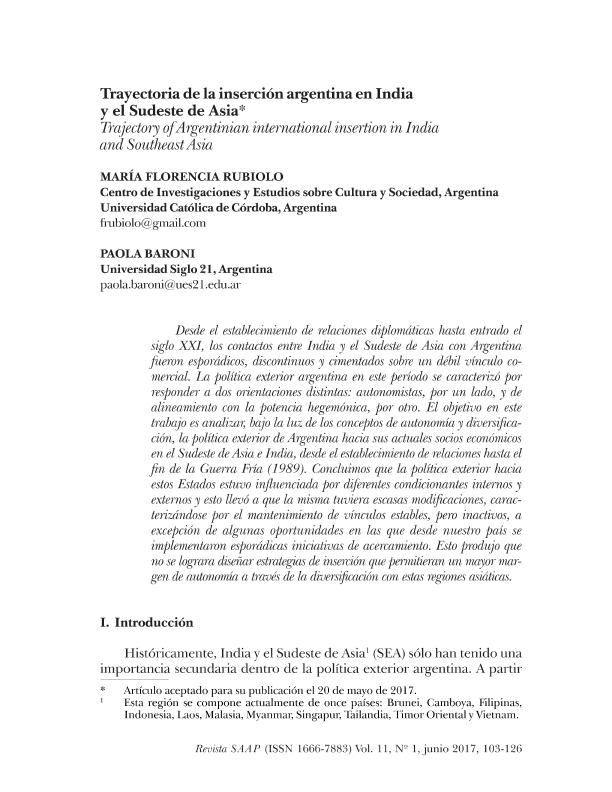Artículo
Desde el establecimiento de relaciones diplomáticas hasta entrado elsiglo XXI, los contactos entre India y el Sudeste de Asia con Argentinafueron esporádicos, discontinuos y cimentados sobre un débil vínculo comercial. La política exterior argentina en este período se caracterizó porresponder a dos orientaciones distintas: autonomistas, por un lado, y dealineamiento con la potencia hegemónica, por otro. El objetivo en estetrabajo es analizar, bajo la luz de los conceptos de autonomía y diversificación, la política exterior de Argentina hacia sus actuales socios económicosen el Sudeste de Asia e India, desde el establecimiento de relaciones hasta elfin de la Guerra Fría (1989). Concluimos que la política exterior haciaestos Estados estuvo influenciada por diferentes condicionantes internos yexternos y esto llevó a que la misma tuviera escasas modificaciones, caracterizándose por el mantenimiento de vínculos estables, pero inactivos, aexcepción de algunas oportunidades en las que desde nuestro país seimplementaron esporádicas iniciativas de acercamiento. Esto produjo queno se lograra diseñar estrategias de inserción que permitieran un mayor margen de autonomía a través de la diversificación con estas regiones asiáticas. Since the establishment of diplomatic relations until well into the twenty-first century, contacts between India and Southeast Asia with Argentina were sporadic, discontinuous and grounded on a weak commercial relationship. Argentina’s foreign policy in this period was characterized for answering to two different orientations: on one side, the autonomist, and on the other, the alignment with the hegemonic power. The objective of this work has been to analyze, under the concepts of autonomy and diversification, Argentina’s foreign policy towards its current economic partners in Southeast Asia and India, since the establishment of their relations until the end of the Cold War (1989). We concluded that the foreign policy towards these states was influenced by different internal and external determinants, and this led that this policy had limited modifications and it was characterized by the maintenance of stable, but inactive links, with the exception of some sporadic initiatives of rapprochement implemented by Argentina. This had as a consequence that it was not possible to design international strategies that provided a greater degree of autonomy through diversification with these Asian regions.
Trayectoria de la inserción argentina en India y el Sudeste de Asia
Título:
Trajectory of Argentinian international insertion in India and Southeast Asia
Fecha de publicación:
06/2017
Editorial:
Sociedad Argentina de Análisis Político
Revista:
Revista S.A.A.P
ISSN:
1666-7883
Idioma:
Español
Tipo de recurso:
Artículo publicado
Clasificación temática:
Resumen
Palabras clave:
Politica Exterior Argentina
,
India
,
Sudeste de Asia
,
Autonomia
,
Diversificación
Archivos asociados
Licencia
Identificadores
Colecciones
Articulos(CIECS)
Articulos de CENTRO DE INVESTIGACIONES Y ESTUDIO SOBRE CULTURA Y SOCIEDAD
Articulos de CENTRO DE INVESTIGACIONES Y ESTUDIO SOBRE CULTURA Y SOCIEDAD
Citación
Rubiolo, María Florencia; Baroni, Paola Andrea; Trayectoria de la inserción argentina en India y el Sudeste de Asia; Sociedad Argentina de Análisis Político; Revista S.A.A.P; 11; 1; 6-2017; 103-126
Compartir




